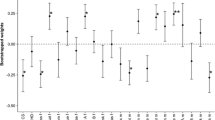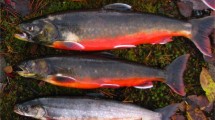Abstract
The Hamilton–Zuk hypothesis proposes that females prefer male secondary sexual traits because they are honest indicators of parasite resistance. Despite the attention that this hypothesis has received, its role in sexual selection remains equivocal. This study presents the first field test in guppies of two key predictions of the Hamilton–Zuk hypothesis: (1) that within populations, the most highly ornamented males have the fewest parasites and (2) that among populations, males in high parasite populations have the most conspicuous ornaments. Five hundred male guppies from 19 distinct populations in the Northern Range of Trinidad were inspected for Gyrodactylus parasites and photographed. Eight measures of orange spot ornamentation were used to test the predictions: hue, saturation, lightness, relative area, number, and area-weighted hue, saturation, and lightness. Parasite load had no significant effect on any of these measures. There was also no relationship between orange spot ornamentation and parasite abundance among populations. Guppies from high-predation environments had significantly more parasites, and their orange coloration was lighter and less saturated than that in guppies from low-predation environments. Despite previous lab results, this study found no relationship between parasite load and male orange spot ornamentation.




Similar content being viewed by others
References
Basolo AL (1990) Female preference predates the evolution of the sword in swordtail fish. Science 250:808–810
Brooks R, Endler JA (2001) Direct and indirect sexual selection and quantitative genetics of male traits in guppies (Poecilia reticulata). Evolution 55:1002–1015
Cohen J (1988) Statistical power analysis for the behavioral sciences. Lawrence Erlbaum, Hilldale
Darwin C (1871) The descent of man, and selection in relation to sex. Appleton, London
Endler JA (1978) A predator’s view of animal color patterns. Evol Biol 11:319–364
Endler JA (1980) Natural selection on color patterns in Poecilia reticulata. Evolution 34:76–91
Endler JA (1983) Natural and sexual selection on color patterns in poeciliid fishes. Environ Biol Fishes 9:173–190
Endler JA (1995) Multiple-trait coevolution and environmental gradients in guppies. Trends Ecol Evol 10:22–29
Endler JA, Houde AE (1995) Geographic variation in female preferences for male traits in Poecilia reticulata. Evolution 49:456–468
Endler JA, Lyles AM (1989) Bright ideas about parasites. Trends Ecol Evol 4:246–248
Faul F, Erdfelder E, Lang A-G, Buchner A (2007) G*Power 3: a flexible statistical power analysis program for the social, behavioral, and biomedical sciences. Behav Res Meth (in press)
Fisher RA (1930) The genetical theory of natural selection. Clarendon, Oxford
Folstad I, Karter AJ (1992) Parasites, bright males, and the immunocompetence handicap. Am Nat 139:603–622
Getty T (2002) Signaling health versus parasites. Am Nat 159:363–371
Goodwin TW (1984) The biochemistry of the carotenoids. Chapman & Hall, London
Grether GF (2000) Carotenoid limitation and mate preference evolution: a test of the indicator hypothesis in guppies (Poecilia reticulata) Evolution 54:1712–1724
Grether GF, Hudon J, Endler JA (2001) Carotenoid scarcity, synthetic pteridine pigments and the evolution of sexual coloration in guppies (Poecilia reticulata). Proc R Soc Lond B 268:1245–1253
Grether GF, Kasahara S, Kolluru GR, Cooper EL (2003) Sex-specific effects of carotenoid intake on the immunological response to allografts in guppies (Poecilia reticulata). Proc R Soc Lond B 271:45–49
Grether GF, Kolluru GR, Rodd FH, Cerda J, Shimazaki K (2005) Carotenoid availability affects the development of a colour-based mate preference and the sensory bias to which it is genetically linked. Proc R Soc Lond B 272:2181–2188
Godin JGJ, Briggs SE (1996) Female mate choice under predation risk in the guppy. Anim Behav 51:117–130
Hamilton WJ, Poulin R (1997) The Hamilton and Zuk hypothesis revisited: a meta-analytical approach. Behaviour 134:299–320
Hamilton WD, Zuk M (1982) Heritable true fitness and bright birds: a role for parasites? Science 218:384–387
Harris PD, Lyles AM (1992) Infections of Gyrodactylus bullatarudis and Gyrodactylus turnbulli on guppies (Poecilia reticulata) in Trinidad. J Parasitol 78:912–914
Houde AE (1997) Sex, color, and mate choice in guppies. Princeton University Press, Princeton
Houde AE, Torio AJ (1992) Effect of parasitic infection on male color pattern and female choice in guppies. Behav Ecol 3:346–351
Hughes KA, Rodd FH, Reznick DN (2005) Genetic and environmental effects on secondary sex traits in guppies (Poecilia reticulata). J Evol Biol 18:35–45
Karino K, Haijima Y (2001) Heritability of male secondary sexual traits in feral guppies in Japan. J Ethol 19:33–37
Karino K, Haijima Y (2004) Algal-diet enhances sexual ornament, growth and reproduction in the guppy. Behaviour 141:585–601
Karino K, Shinjo S (2004) Female mate preference based on male orange spot patterns in the feral guppy Poecilia reticulata in Japan. Ichthyol Res 51:316–320
Kennedy CEJ, Endler JA, Poynton SL, McMinn H (1987) Parasite load predicts mate choice in guppies. Behav Ecol Sociobiol 21:291–295
Kodric-Brown A (1989) Dietary carotenoids and male mating success in the guppy: an environmental component to female choice. Behav Ecol Sociobiol 25:393–401
Kodric-Brown A, Brown JH (1984) Truth in advertising: the kinds of traits favored by sexual selection. Am Nat 124:305–322
Kodric-Brown A, Nicoletto PF (2001) Female choice in the guppy (Poecilia reticulata): the interaction between male color and display. Behav Ecol Sociobiol 50:346–351
López S (1998) Acquired resistance affects male sexual display and female choice in guppies. Proc R Soc Lond B 265:717–723
Luyten PH, Liley NR (1985) Geographic variation in the sexual behaviour of the guppy, Poecilia reticulata (Peters). Behaviour 95:164–179
Luyten PH, Liley NR (1991) Sexual selection and competitive mating success of male guppies (Poecilia reticulata) from four Trinidad populations. Behav Ecol Sociobiol 28:329–336
Lyles AM (1990) Genetic variation and susceptibility to parasites: Poecilia reticulata infected with Gyrodactylus turnbulli. Ph.D. Thesis, Princeton University, New Jersey
Magurran AE (1999) The causes and consequences of geographic variation in antipredator behavior: perspectives from fish populations. In: Foster SA, Endler JA (eds) Geographic variation in behavior: perspectives on evolutionary mechanisms. Oxford University Press, Oxford, pp 139–163
Maynard Smith J (1978) The evolution of sex. Cambridge University Press, London
McLennan DA, Brooks DR (1991) Parasites and sexual selection: a macroevolutionary perspective. Q Rev Biol 66:255–286
McMinn H (1990) Effects of the nematode parasite Camallanus cotti on sexual and non-sexual behaviors in the guppy (Poecilia reticulata). Am Zool 30:245–249
Møller AP (1990) Parasites and sexual selection: current status of the Hamilton and Zuk hypothesis. J Evol Biol 3:319–328
Møller AP, Christie P, Lux E (1999) Parasitism, host immune function, and sexual selection. Q Rev Biol 74:3–20
Nicoletto PF (1993) Females respond to condition-dependent ornaments in the guppy, Poecilia reticulata Anim Behav 46:441–450
Oosterhout CV, Harris PD, Cable J (2003) Marked variation in parasite resistance between two wild populations of the Trinidadian guppy, Poecilia reticulata. Biol J Linn Soc 79:645–651
Pomiankowski A (1987) The costs of choice in sexual selection. J Theor Biol 128:195–218
Read AF (1990) Parasites and the evolution of host sexual behavior. In: Barnard CJ, Harvey PH (eds) Parasitism and host behaviour. Taylor and Francis, London, pp 117–157
Reznick D, Endler JA (1982) The impact of predation on life history evolution in guppies. Evolution 36:160–177
Reznick DN, Shaw FH, Rodd FH, Shaw RG (1997) Evaluation of the rate of evolution in natural populations of guppies (Poecilia reticulata). Science 275:1934–1937
Rodd HF, Hughes KA, Grether GF (2002) A possible non-sexual origin of mate preference: are male guppies mimicking fruit? Proc R Soc Lond B 269:475–481
Ryan MJ (1990) Sexual selection, sensory systems, and sensory exploitation. Oxf Surv Evol Biol 7:157–195
Schall JJ, Staats CM (1997) Parasites and the evolution of extravagant male characters: Anolis lizards on Caribbean islands as a test of the Hamilton–Zuk hypothesis. Oecologia 111:543–548
Scott ME, Anderson RM (1984) The population dynamics of Gyrodactylus bullatarudis (Monogenea) within laboratory populations of the fish host Poecilia reticulata. Parasitology 90:159–194
Thomas L (1997) Retrospective power analysis. Conserv Biol 11:276–280
Trivers RL (1972) Parental investment and sexual selection. In: Campbell (ed) Sexual selection and the descent of man. Aldine, Chicago, pp 1871–1971
Acknowledgements
O. Lau and R. Hernandez provided excellent support with fieldwork in Trinidad. K. Hughes, G. Grether, and H. Rodd gave advice on project design and logistics. S. Alberts, M. Cummings, K. Hughes, H. Rodd, W. Morris, T. Getty, and one anonymous reviewer offered valuable criticism of the manuscript. K. Hughes, W. Morris, M. Lavine, D. Stangl, and G. Puggioni were consulted on statistical analyses. The Simla Research Station run by the ASA Wright Nature Center provided accommodation in Trinidad. Trinidad’s Water and Sewage Authority generously allowed work in the Quare drainage. This work was funded by a Summer Enrichment Grant from the Duke University Scholars Program, a Latin American Studies Grant from the Mellon Foundation, a Deans’ Summer Fellowship, and the Undergraduate Research Support Program, all at Duke University. SJ was supported in part by a grant from the National Science Foundation (IOB-0444674). All protocols used in this study were approved by the Duke Institutional Animal Care and Use Committee (registry #A078-04-03) and comply with the current laws of Trinidad and Tobago.
Author information
Authors and Affiliations
Corresponding author
Additional information
Communicated by C. St. Mary
Appendix
Appendix
Rights and permissions
About this article
Cite this article
Martin, C.H., Johnsen, S. A field test of the Hamilton–Zuk hypothesis in the Trinidadian guppy (Poecilia reticulata). Behav Ecol Sociobiol 61, 1897–1909 (2007). https://doi.org/10.1007/s00265-007-0430-2
Received:
Revised:
Accepted:
Published:
Issue Date:
DOI: https://doi.org/10.1007/s00265-007-0430-2




